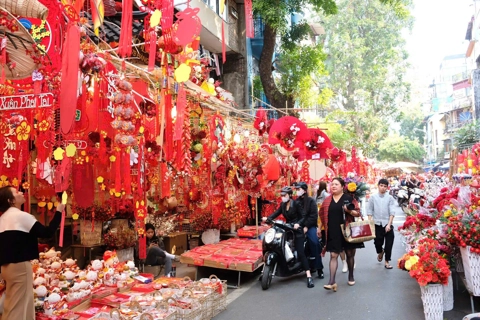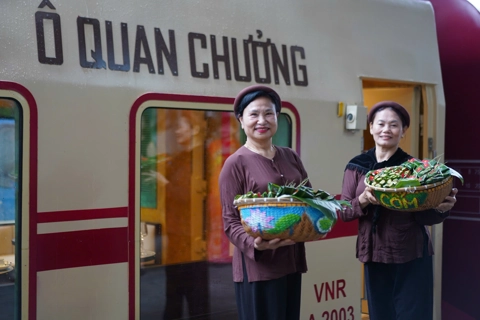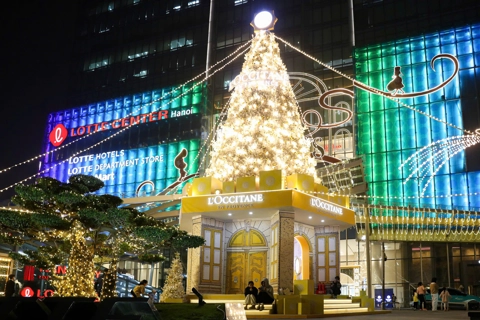Life
Exhibition “Reimagine the Artist/Artisan” opens in Hanoi
Jan 05, 2017 / 02:02 PM
The exhibition “Reimagine the Artist/Artisan” by 5 creative artworks was kicked off at the Six Space on January 5.
Observing the modernization and commercialization process which has gradually eroded the traditional craft villages in Vietnam as at the same time the crisis of young artists struggling to find a new mediums of expressing their ideas and seeking inspiration for their creations, the organizer has initiated and implemented the “Reimagine the artist/ artisan” project in 2016 with generous support from Prince Claus Foundation.
Over the last 12 months, the artists from the project have visited and conducted intensive research in more than 50 craft villages in the Red River area. They then have continuous conversations and worked tightly with artisans from some of the chosen villages. Along with this mutual learning and creative process, there were talks and workshops retelling stories from those villages to a wider public in Hanoi. The interaction and exchange between artist – artisan – researcher – the audience is a very crucial part in shaping the final art works. The organizer wants to pose again the question about the whether the author of a work of art is really important. Where is the borderline between folk art and academia art? How was the relation between technique and concept shown in arts and crafts?
5 creative artworks from Nguyen Huy An, Ngo Thanh Bac, Le Giang, Tran Thu Hang and Dao Le Hong My in collaboration with the artisans are the different approaches that we would like us to interpret and answer for those questions. Trained under the influence from Western aesthetic, five artists have approached and applied the traditional materials in many dynamic ways: from materials, images or the stories they want to tell. The main inspiration from all the works come from life and spiritual myths. The return to traditional materials and this spiritual and folk theme is a way for the artists to find their cultural roots to apply in their creative works and contemporary design following the flow of time in the trend of urbanization and globalization. Besides, the artworks from Reimagine the artist/ artisan which are the experiment combining between artistic concept, techniques and artisan’s tales, attempted to take the first step to create new creative works for the traditional villages. In the piece The One Who Chews the Betel Is Mute is the close process between Le Giang and the artisans from Chuon Ngo mussel mosaic village. The traditional wood material from the betel casket was replaced by plaster. The artist designed the new patterns based on blueprints of the traditional village textures. Motifs of birds, butterflies were replaced by the unshaped abtract forms. From the artist’s sketch, the artisan combines different colors from pieces of clams, snails, abalones. Following her interest in imagination about utopia and questions regarding future, the work was presented in a form of a betal casket found from a faraway history with characteristic and details suggesting the past of Vietnamese people. Vietnamese over the past thousand years have created the philosophy of betel with the dialectial manner beliving that the betel carries a heavy social identity (means of communication) and personal identity. The betel casket which was originally used to contain the means of communication is now being blogged hinting private emotions, secretive concerns which could not be said into words.
In the piece The One Who Chews the Betel Is Mute is the close process between Le Giang and the artisans from Chuon Ngo mussel mosaic village. The traditional wood material from the betel casket was replaced by plaster. The artist designed the new patterns based on blueprints of the traditional village textures. Motifs of birds, butterflies were replaced by the unshaped abtract forms. From the artist’s sketch, the artisan combines different colors from pieces of clams, snails, abalones. Following her interest in imagination about utopia and questions regarding future, the work was presented in a form of a betal casket found from a faraway history with characteristic and details suggesting the past of Vietnamese people. Vietnamese over the past thousand years have created the philosophy of betel with the dialectial manner beliving that the betel carries a heavy social identity (means of communication) and personal identity. The betel casket which was originally used to contain the means of communication is now being blogged hinting private emotions, secretive concerns which could not be said into words.
 In the work Do I Have to Introduce My Name Here?, Ngo Thanh Bac has created a small puppet theatre to continue writing the story of the Appendix. The Appendix is a performance collective founded in 2010 which has worked closely together. In the Appendix’s works, the members always appeare in uniform with white shirt and black pants to perform durational actions using everyday life objects as prop. The work is like Bac’s reflection to questions of the artist’s role in the contemporary life. New contemporary arts mediums such as performances, installations have become popular in Vietnam in the late 90s and early 2000 and there are a big distance between those new medium and the audience. The majority of the audience for those so-called experimental exhibitions was mainly people from the art world or foreigners living in Vietnam. Bac possibly would like to bring an art form that seems to be very distant to express in puppetry which is a very community central art form. It could be a metaphor for life as a big puppetry show with many unknown characters that whenever any one comes up they would ask the question to the audience “Do I have to introduce my name here?”
In the work Do I Have to Introduce My Name Here?, Ngo Thanh Bac has created a small puppet theatre to continue writing the story of the Appendix. The Appendix is a performance collective founded in 2010 which has worked closely together. In the Appendix’s works, the members always appeare in uniform with white shirt and black pants to perform durational actions using everyday life objects as prop. The work is like Bac’s reflection to questions of the artist’s role in the contemporary life. New contemporary arts mediums such as performances, installations have become popular in Vietnam in the late 90s and early 2000 and there are a big distance between those new medium and the audience. The majority of the audience for those so-called experimental exhibitions was mainly people from the art world or foreigners living in Vietnam. Bac possibly would like to bring an art form that seems to be very distant to express in puppetry which is a very community central art form. It could be a metaphor for life as a big puppetry show with many unknown characters that whenever any one comes up they would ask the question to the audience “Do I have to introduce my name here?”
 In the piece The Dome Space, An continues to follow his interest in exploring femininity and sexuality hidden in traditional culture and Mother Goddess religion. An has worked with artisans from Dong Cuu village which was an embroidery village serving for the traditional religion and beliefs. In the past, the artisans played the role of realizing abstract concept in the community consciousness. Nowadays, the artists intervene by giving images inspired from the artisans’ old products – a new way of looking at the past. The shoes by Lieu Hang goddess in An’s work were hidden in a sealed box that we could only see a magical space full of imagination about images of a spiritual realms both vaguely and familiarly.
In the piece The Dome Space, An continues to follow his interest in exploring femininity and sexuality hidden in traditional culture and Mother Goddess religion. An has worked with artisans from Dong Cuu village which was an embroidery village serving for the traditional religion and beliefs. In the past, the artisans played the role of realizing abstract concept in the community consciousness. Nowadays, the artists intervene by giving images inspired from the artisans’ old products – a new way of looking at the past. The shoes by Lieu Hang goddess in An’s work were hidden in a sealed box that we could only see a magical space full of imagination about images of a spiritual realms both vaguely and familiarly.
 The Silent Fire by Tran Thu Hang was inspired by the burning votive tradition in Vietnamese folk culture. In Brahmin, fire plays the role of transmiting offerings; in Tantric Buddhism, fire combines with mandala was considered to have “power”, “magic”) which gave birth to the folk belief in burning votive. Mã in Sino-Vietnamese means look therefore the votive were adapted to the outer look of the real objects and made of bamboo and rice paper to burn for the dead. The votive is like the string connected the Yin and Yang elements and have always been cherished as a memberence of the desceased. With the unconditional and irrational belief was symbolized in votive burning, Vietnamese people believed that the fire could transform paper into any kind of materials. The votive attracted Hang with the unconditional belief and the adaptability and flexibility to the flow of history at the same time with the high level of metaphor. The costumes in The Silent Fire that were made from wearable materials take inspiration from the votive objects to keep the imitation in the decoration, folk metaphor and typical religious characters. Everything were arranged in a harmonious rhyme to recreate the material transformative door according to folk belief.
The Silent Fire by Tran Thu Hang was inspired by the burning votive tradition in Vietnamese folk culture. In Brahmin, fire plays the role of transmiting offerings; in Tantric Buddhism, fire combines with mandala was considered to have “power”, “magic”) which gave birth to the folk belief in burning votive. Mã in Sino-Vietnamese means look therefore the votive were adapted to the outer look of the real objects and made of bamboo and rice paper to burn for the dead. The votive is like the string connected the Yin and Yang elements and have always been cherished as a memberence of the desceased. With the unconditional and irrational belief was symbolized in votive burning, Vietnamese people believed that the fire could transform paper into any kind of materials. The votive attracted Hang with the unconditional belief and the adaptability and flexibility to the flow of history at the same time with the high level of metaphor. The costumes in The Silent Fire that were made from wearable materials take inspiration from the votive objects to keep the imitation in the decoration, folk metaphor and typical religious characters. Everything were arranged in a harmonious rhyme to recreate the material transformative door according to folk belief.
 Fascinated by the improvisation and flexibitly in using recycled malfunctioned handmade products in Huong Canh ceramic village where the artist went to for research, Dao Le Hong My collected those materials and transformed them into products with new appliance. The chairs from My’s work, The Strata weren’t just a creation using old materials but also brought a new experience of time and history for the audience. The work is also the most applicable and interactive piece since it could totally escape from the exhibition space to use in everyday life in those street corner stalls or the small countryside snack still existing.
Fascinated by the improvisation and flexibitly in using recycled malfunctioned handmade products in Huong Canh ceramic village where the artist went to for research, Dao Le Hong My collected those materials and transformed them into products with new appliance. The chairs from My’s work, The Strata weren’t just a creation using old materials but also brought a new experience of time and history for the audience. The work is also the most applicable and interactive piece since it could totally escape from the exhibition space to use in everyday life in those street corner stalls or the small countryside snack still existing.
Over the last 12 months, the artists from the project have visited and conducted intensive research in more than 50 craft villages in the Red River area. They then have continuous conversations and worked tightly with artisans from some of the chosen villages. Along with this mutual learning and creative process, there were talks and workshops retelling stories from those villages to a wider public in Hanoi. The interaction and exchange between artist – artisan – researcher – the audience is a very crucial part in shaping the final art works. The organizer wants to pose again the question about the whether the author of a work of art is really important. Where is the borderline between folk art and academia art? How was the relation between technique and concept shown in arts and crafts?
5 creative artworks from Nguyen Huy An, Ngo Thanh Bac, Le Giang, Tran Thu Hang and Dao Le Hong My in collaboration with the artisans are the different approaches that we would like us to interpret and answer for those questions. Trained under the influence from Western aesthetic, five artists have approached and applied the traditional materials in many dynamic ways: from materials, images or the stories they want to tell. The main inspiration from all the works come from life and spiritual myths. The return to traditional materials and this spiritual and folk theme is a way for the artists to find their cultural roots to apply in their creative works and contemporary design following the flow of time in the trend of urbanization and globalization. Besides, the artworks from Reimagine the artist/ artisan which are the experiment combining between artistic concept, techniques and artisan’s tales, attempted to take the first step to create new creative works for the traditional villages.













